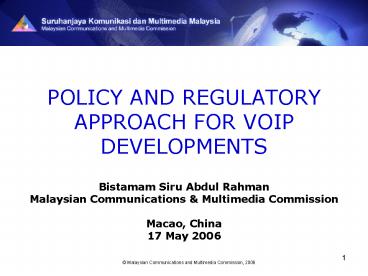POLICY AND REGULATORY APPROACH FOR VOIP DEVELOPMENTS - PowerPoint PPT Presentation
1 / 9
Title:
POLICY AND REGULATORY APPROACH FOR VOIP DEVELOPMENTS
Description:
Malaysian Communications and Multimedia Commission, 2006. 1. VoIP: Voice ... both IP-based networks and the public Internet for the conveyance of voice calls. ... – PowerPoint PPT presentation
Number of Views:22
Avg rating:3.0/5.0
Title: POLICY AND REGULATORY APPROACH FOR VOIP DEVELOPMENTS
1
POLICY AND REGULATORY APPROACH FOR VOIP
DEVELOPMENTS
- Bistamam Siru Abdul Rahman
- Malaysian Communications Multimedia Commission
- Macao, China
- 17 May 2006
2
1. VoIP Voice or Data?
- VOIP is transmission of real-time voice using IP
- Offered on converged IP platform
- Can provide voice, data and video
- IP datagram encapsulates voice
- Transmission in data form but could be voice at
customer end - Consumers dont care voice or data
- More of a regulatory issue
3
2. VoIP Offers
- Effective competition
- Lowers barriers to entry
- Reduced calling prices
- Voice calls over broadband
- Service innovation and rich features
- Normadicity of numbers
- Convergence of voice , data and video
- Migration platform for NGN
4
3. Peer to Peer
- No Gateways involved
- Protocol Used SIP/ H.323
- Need to know IP Address or consult directory
server or remain online - Users connected to ISP via PSTN
- Broadband connection via ADSL, cable or wireless
- PSTN by-passed except for access leased
facilities - A matter between users - not easy to detect or
regulate Skype, Yahoo BB
5
4. State of Competition in VoIP Markets
100
2
80
29
60
40
20
1
2
7
0
Africa
Americas
Arab States
Asia-Pacific
Europe/CIS
No policy for VoIP Telephony The respondent did
not answer this specific question, or indicated
that there was no current policy, or that a new
policy is currently being formulated.
Full competition All public telecommunication
operators (PTO), whether licensed or not, may use
both IP-based networks and the public Internet
for the conveyance of voice calls.
Partial competition Non-licensed PTOs may use
either IP-based networks or the public Internet
for the conveyance of voice calls.
Prohibited All PTOs (even licensed ones) are
prohibited from using IP-based networks or the
public Internet for the conveyance of voice calls.
Restricted Only licensed PTOs are able to use
IP-based networks or the public Internet for the
conveyance of voice calls.
Source ITU World Telecommunication Regulatory
Database
6
5. KEY REGULATORY DRIVERS
- Classification of VoIP as a traditional Voice
line service or different treatment - Policies regulating unbundling and infrastructure
sharing (e.g., collocation) - Service level obligations between operators
- Policies on numbering availability, nature (i.e.,
geographic vs non-geographic) and portability - Regulatory environment around broadband
- Treatment of interconnection (single tandem
termination prices) (originating and terminating) - Policies on pricing of leased lines, equipment
building sharing, etc - Policies on retail pricing for VoIP providers
- Pricing / bundling flexibilities for incumbents
- Policies on emergency calls to police / fire
(i.e., tracking call localization) - Obligation to ensure wiretapping possibility
- Clearly impacts attractiveness for/of
- Consumers for instance through numbering, access
to emergency calls, arbitrage margins - Economics of attacker through unbundling options
and fees, interconnection charges, VoIP
classification
7
6. VOIP in Malaysia
- To promote competition through low entry barriers
- Benefits users by lower prices and innovation
- Application Service Provider (C)
- Contribution to Universal Service
- VOIP up to 80 reduction on Intl calls
- VOIP market only 4
- VOIP Revenue 70 IDD and 30 STD
- VOIP Revenue Prepaid 41 and Postpaid 59
8
7. VOIP in Malaysia (2)
- Guidelines on VOIP (2001)
- PC to PC- based or Internet telephony
- Phone to phone based through PSTN, using
multistage access dialing (VoIP) - Guidelines on Telephony Services over IP (2005)
- Emergency, Directory and Operator Assisted
Services - Allocation of non-geographic numbers
- Interconnection Fixed Network includes IP
9
8. Conclusion
- Engine for economic growth for countries
- Benefit for end users for competitive services
- New revenue opportunities for incumbents
- Promotes competition, lower barrier to entry
- Light handed approach for growth of VOIP
- Stimulates innovation in technologies,
applications and services






























